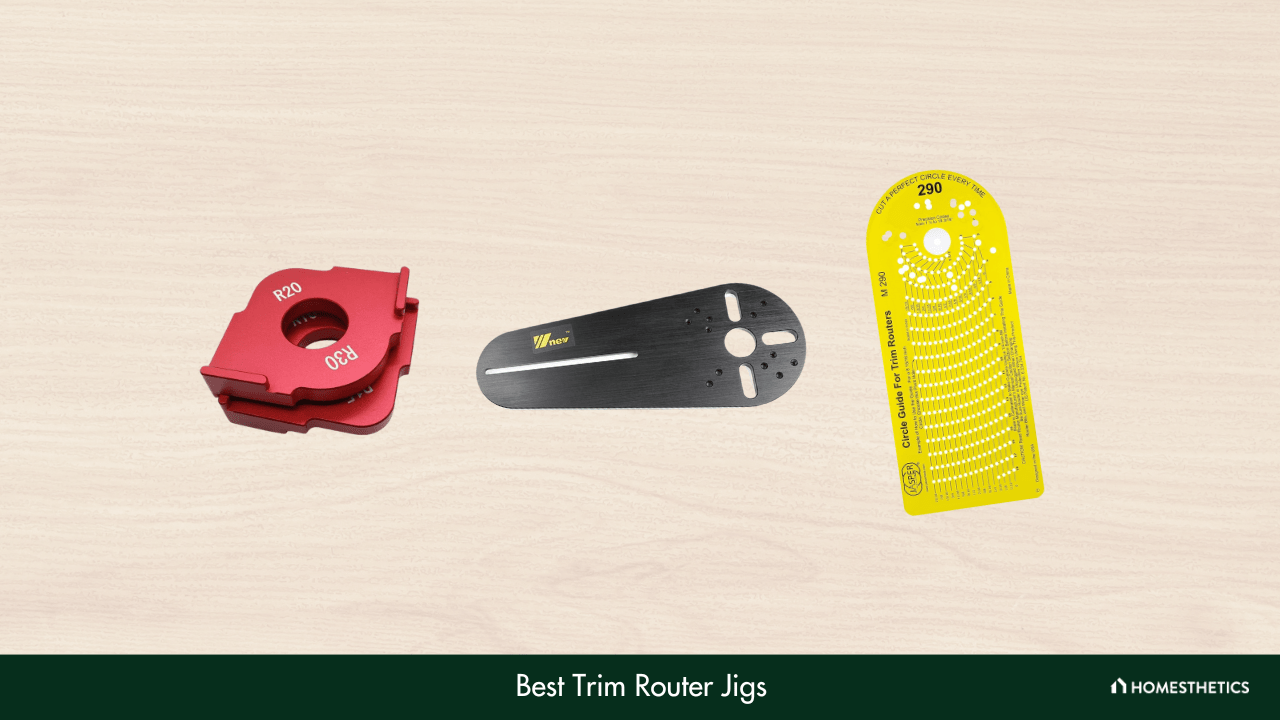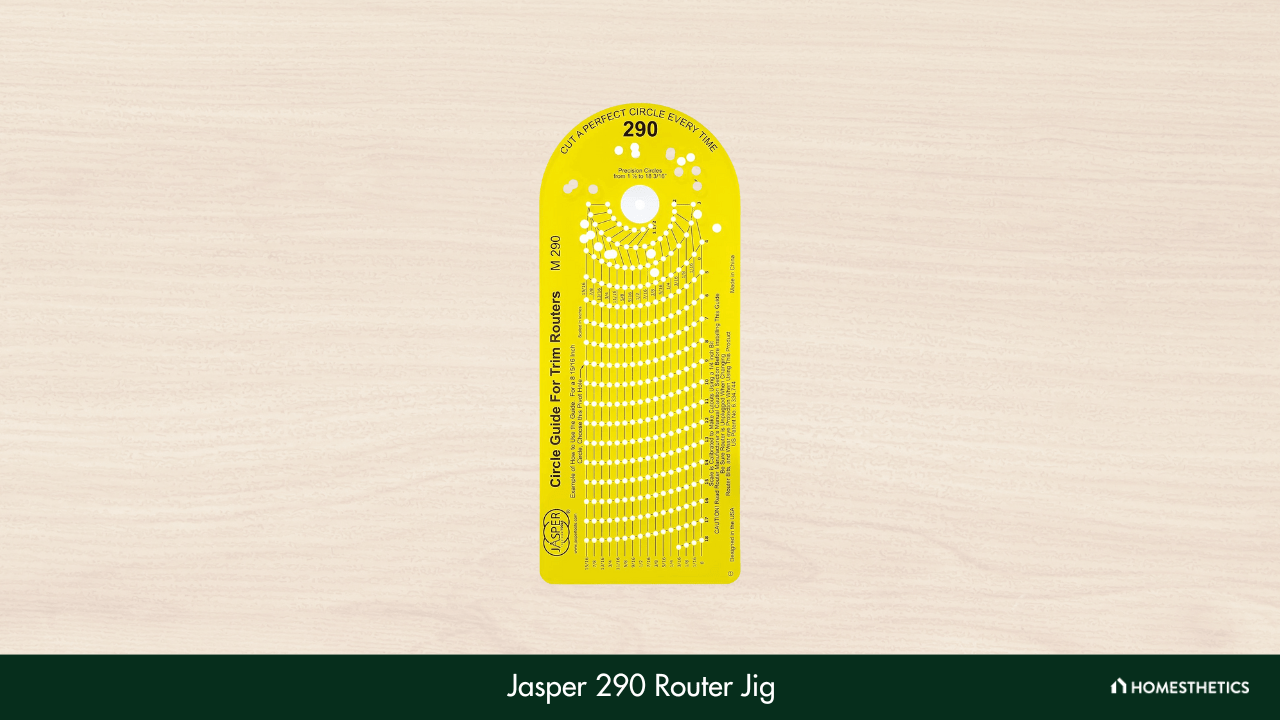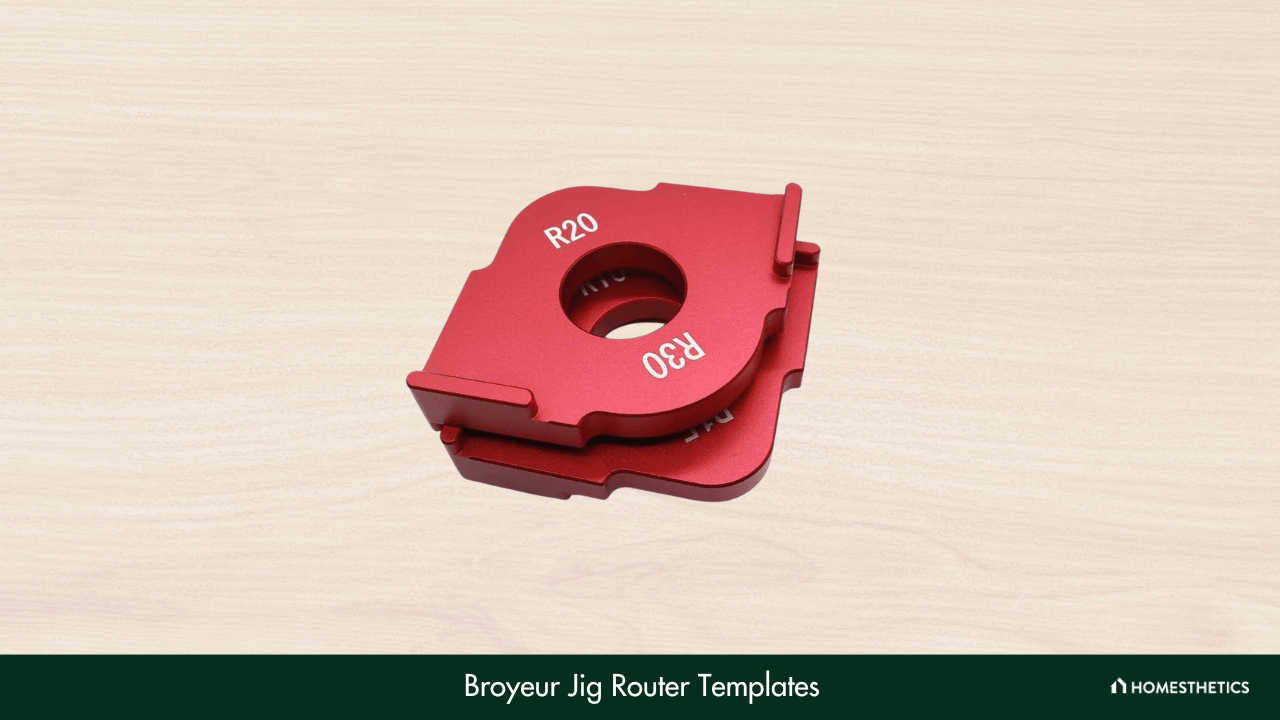The Jasper 290 is the best jig for a trim router, thanks to its versatility. BTMIEY circle cutting jig is incredibly easy to use while with the Broyeur jig router templates, you get a durable and affordable option to enhance your woodworking skill.

A router is one of the most useful woodworking machines that you can get. Many different types of routers exist, but the trim router is one of the most common router types. It is used for trimming wood surfaces and cutting through laminate materials. You can improve the utility of such a router with a jig, which is a type of woodworking template for different kinds of tasks.
But first, you’ll need to pick the best router jig, which can be a bit challenging. That’s why I have made this guide reviewing some of the best options available today.
Listed below are the best trim router jigs for home woodworking projects:
- Jasper 290 router jig: The Jasper 290 stands out for its versatility, accommodating various routers and offering precise circle cutting in 268 sizes (1-1/2” to 18-3/16”). Though effective, its higher cost is worth considering.
- BTMIEY circle cutting jig: The BTMIEY jig, recognized for its simplicity, offers an easy setup with three variants tailored to specific uses. Crafted from durable bakelite, it provides a reliable cutting diameter of 20 mm to 690 mm.
- Broyeur jig router templates: The Broyeur templates, blending affordability and durability, are crafted for cutting radii on wood boards. Constructed from robust aluminum alloy, it features four radii options (10 mm to 30 mm). While not the most versatile, it excels in creating rounded corners on furniture.
1. Jasper 290 router jig - Best versatile trim router jig
What We Like
- Highly versatile
- Compatible with a variety of routers
- Durable build quality
- Easy to use
What We Don't Like
- Not very budget-friendly
The Jasper 290 is possibly one of the best trim router jigs that you can get. It can help you cut perfect circles on the workpiece in a wide range of sizes.
To be more precise, this trim router accessory comes with a large number of cutting holes that allow you to cut circles in 268 different sizes. The radii of these circles range from 1-1/2” to 18-3/16”, thereby making it a highly versatile tool.
It can be used with a wide range of routers, which further enhances its versatility. What’s more, as I tested it, I found it incredibly easy to use as well. Additionally, the jig is made from premium-quality, hardened acrylic materials, which makes it quite durable.
However, I noticed that this particular option comes with a fairly high price tag compared to other trim router jigs. This can make it a bit difficult to purchase, especially if your budget is low.
Material: Acrylic | Cutting Range: 25 mm to 460 mm | Weight: 11.3 oz.
2. BTMIEY circle cutting jig - Best ease of use
What We Like
- Easy to set up and use
- It comes in three different variants
- Built to last
- Good cutting diameter range
What We Don't Like
- Compatible with only a few router models
For this review, I have selected the circle cutting jig by BTMIEY. This option has a simple design, which makes it very easy to set up on your trim router. And once you have completed the setup, you can use it for cutting circles and performing other similar woodworking tasks.
I noticed that it comes in three different variants, with each having specific use and compatibility options. Based on my personal trials, I would say that the first type is great for general drilling activities on plywood and hardwood.
The other two have pre-drilled holes for specific trim router models. While it makes the tool easy to use, it does hamper its versatility to a great extent. That’s because you won’t be able to fit the jig into any router except the compatible ones.
This jig is made out of hardened bakelite, which is quite durable. Also, you get a cutting diameter that ranges between 20 mm and 690 mm, which is well-suited for most tasks.
Material: Aluminum | Cutting Range: 20 mm to 690 mm | Weight: 24.32 oz.
3. Broyeur jig router templates - Best durability
What We Like
- Affordably priced
- Easy to use
- Highly durable
- Available in different radii
What We Don't Like
- Not very versatile
Next, I reviewed the Broyeur jig router templates, which can be used for cutting perfect radii on wood boards. My hands-on review showed that it is very easy to use - just place the jig at the corner of the workpiece and drill through the surface with your router. As such, it is particularly great for making rounded corners on tables and other furniture.
This router jig is made from highly durable aluminum alloy, which keeps it protected from scratches and damage. Likewise, the surface has been treated by anodic oxidation, thereby making it rustproof and dust-resistant.
Compared to other types of router jigs, this option is very affordable, which makes it a worthy investment. The packaging includes two router templates that have four different radii - 10 mm, 15 mm, 20 mm, and 30 mm.
However, the router templates are not very versatile since they can only be used for cutting circular corners and a few other woodworking tasks.
Material: Wood, aluminum | Cutting Range: 10 mm to 30 mm | Weight: 10.2 oz.
What makes a trim router jig the best choice in terms of material, cutting range, and weight?
Explore the key features of top trim router jigs, vital tools for DIY woodworking enthusiasts. These jigs vary in material, cutting range (in millimeters, mm), and weight (in ounces, oz.), making them valuable assets for various home improvement projects.
| Trim Router Jigs | Material | Cutting Range | Weight |
|---|---|---|---|
| Jasper 290 Router Jig | Acrylic | 25 mm to 460 mm | 11.3 oz. |
| BTMIEY Circle Cutting Jig | Aluminum | 20 mm to 690 mm | 24.32 oz. |
| Broyeur Jig Router Templates | Wood, aluminum | 10 mm to 30 mm | 10.2 oz. |
Trim router jigs buyer’s guide
In this section, I have discussed some key factors that you need to keep in mind when choosing a woodworking jig for your trim router. Read on!
1. Intended usage
The most important aspect that needs to be considered is the intended usage of the jig. That’s because these woodworking tools are usually designed to perform a specific set of tasks. In other words, you will need a specific kind of router jig for a given task. Therefore, if you perform different types of woodworking activities, you will need separate jigs for each task unless otherwise specified by the manufacturer.
For instance, if you wish to create a dovetail joint, you will need a dovetail jig. Likewise, if you want to create a dado or a mortise and tenon joint, you will need an appropriate tool for those tasks as well.
2. Ease of use
One of the primary purposes of a router jig is to reduce the complexity of a woodworking task and make it easier by providing a suitable working template. That’s why the jig needs to be easy to use, or else the entire point of the tool will be defeated.
You need to ensure that the jig can be easily set up and attached to the main router machine. Similarly, it should come with all the necessary usage details and instructions, along with spare components, such as the screw, router bits, drill bit, clamp, attachment pins, and so on.
3. Durability
Another important factor that you need to keep in mind is durability, which is determined by the materials used for making it. Most routers are used on different types of surfaces, such as hardwood, plywood, medium-density fibreboard, and even metal in some cases.
If the jig is made from low-quality materials, it won’t be able to withstand these loads, thereby becoming damaged or worn out. Therefore, you need to ensure that the jig is made from high-quality, sturdy materials like steel, aluminum, and so on.
4. Compatibility
There are different types of routers available today, which is why you will need to determine the compatibility of the tool before purchasing.
For instance, a trim router is not the same as a regular router, which means that the jigs for these two routers will be different as well. Similarly, some jigs are compatible with certain brands of routers and incompatible with others. So, you’ll need to check this aspect before spending your hard-earned money.
What types of woodworking tasks can be done with jigs?
The types of woodworking tasks that can be done with jigs encompass a wide variety. They can be used for machining lumber, drilling holes, creating patterns, and establishing joineries such as dadoes, dovetails, and mortise joints. Please note that if a jig is specifically designed for a certain task, it should be used exclusively for that, unless otherwise specified.
Do I need to use a router table with a jig?
Whether or not you need a router table with a jig largely depends on the specific woodworking task you're undertaking. For some tasks, such as making joineries like dadoes, dovetails, or mortise joints, a router table may enhance precision and control, especially when used with a jig. Certain tasks or jig types may not necessitate one.
Is it safe to use a trim router jig?
Yes, it is safe to use a jig with a trim router tool. A typical router jig won’t cause any additional damage or wear to the trim router. Some routers are designed to have the opposite effect, where they can protect the blade and drill bits against damage.
Similarly, a router jig won’t cause any injuries or harm to you either. Of course, you will need to follow the necessary safety precautions before starting the task.
What are the biggest benefits of using jigs?
The biggest benefits of using router jigs are their accuracy and simplicity. Woodworking tasks can be fairly complex, and if you do not have good accuracy, the end product might not be what you expect. Luckily, a jig helps to reduce this complexity to a great extent, which consequently improves the accuracy of the router.
So, those are the top three trim router jigs you can purchase. My personal favorite is the Jasper 290 router jig, as it offers great versatility for creating perfect circles on wooden workpieces and is compatible with a wide range of routers. Be sure to check out the buyer's guide and FAQs for valuable information to aid in your purchase decision.



